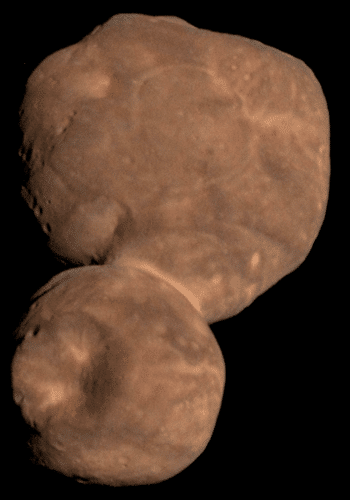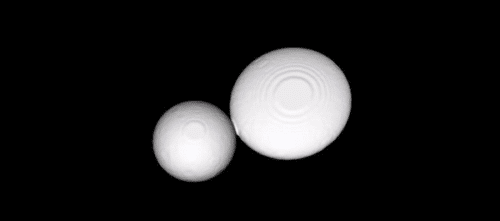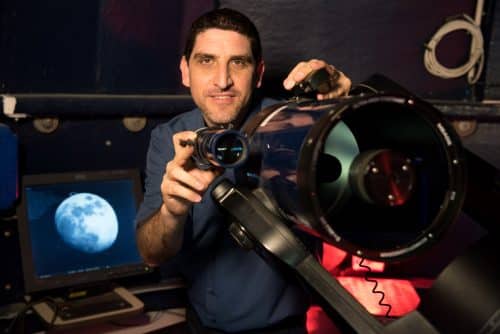A model developed in the Faculty of Physics at the Technion explains the unique characteristics of Arrokoth - an object photographed by the New Horizons probe in 2019. The model has important implications for understanding the first steps in the formation of planets

Researchers at the Faculty of Physics at the Technion and their colleagues in Germany have published in Nature an explanation of the unique characteristics of the "snowman", the most distant object in the system that has been mapped and photographed up close. In early 2006, the New Horizons probe was sent to take close-up photos of Pluto, the only planet in the solar system that has not yet been mapped. The mission: to map Pluto and learn about its properties and its surface. Back in the same year, the International Astronomical Union (IAU) determined that Pluto is not a "real" planet but a planetoid, a dwarf planet, and thus narrowly reduced the family of the solar system from 9 planets to only 8. Of course, all this did not stop the New Horizons mission, which arrived at Pluto about 9 years after launch and provided a lot of visual and scientific information about Pluto and its moon Charon. From there the probe continued to the edge of the solar system. On December 27, 2017, NASA turned off New Horizons' systems to save energy and turned them back on six months later.
The journey beyond Pluto is designed to study 2014 MU69 - a celestial object located about 6 billion kilometers from Earth in the Kuiper belt - an asteroid belt that contains a huge number of asteroids ranging in size from a few meters to objects thousands of kilometers in size (Pluto, for example). Here, unlike the inner asteroid belt that lies between the orbits of Mars and Jupiter, the temperatures are very low and therefore some of those objects are made of ice. MU69 was discovered in 2014 by the Hubble Space Telescope, and due to the great interest in it, it was decided that it would be New Horizons' next target after Pluto. And so, on January 1, 2019, the probe passed by MU69 and photographed it from a minimum distance of 3,500 kilometers.
Due to its distance from Earth - about 6 billion kilometers from us - NASA personnel gave the remote body the name Ultima Thule ("end of the world" loosely translated from Latin, because of its location at the edge of the solar system). His name was later changed to Arrokoth, a word meaning "sky" or "cloud" in the extinct Powhatan Indian language. The photographs of New Horizons, and additional information that came from Hubble and other sources, provided the scientific community with a lot of information about the distant bone, which is about 30 kilometers long and consists of two flattened "lobes" of different sizes connected to each other by a kind of thin neck. This is the origin of another nickname given to the bilobed bone - "the snowman".
Although it was already agreed at an early stage that Arrokoth was formed by the collision of two different objects - the two lobes that make it up - the models proposed so far do not explain the main features of the "snowman", in particular its slow rotation speed around itself, and its high angle of inclination. Now, in an article in the renowned journal Nature, Technion researchers present a simulation-based model that matches the same features.

The research was led by doctoral student Yevgeni Grishin, post-doctoral student Dr. Uri Melmud and their supervisor Prof. Hagi Peretz, with a German research group. According to Grishin, "a simple collision between two accidental objects in the Kuiper belt would have shattered them because they are mostly made of soft ice, and the collision would have occurred at too high a speed. Therefore we assumed that the collision was preceded by a long period in which the two bodies circled each other in a circular orbit, similar to the moon circling the earth. During this period, the bodies gradually approached each other, and when they hit each other in the end, it was not a fatal collision but a kind of friction."
To that two-body system, the Technion researchers added a third object, the sun, and thus turned it into a three-body system. Now another problem remains - if the two parts of Arrokoth moved in a circle around each other, it is difficult to explain the current motion data of the shared object, including its low rotation speed and its large inclination angle (the tilt relative to the plane of rotation around the Sun), which is 98 degrees - so that it is almost lying on its side relative to its course. "Our simulations also solved this problem," says Prof. Peretz. "We showed that at the beginning of the journey the two bodies moved in a circular path and at a great distance from each other, then over time the path became more and more elliptical due to the interference of the forces of attraction between the three bodies, and at certain points the two lobes of Arrokoth come very close together. Such a situation is expected to lead to a collision at a slow speed, which will not shatter the colliding objects but will cause them to stick together, and moreover - cause the final rotation speed of the common object to be low and the angle of inclination high."
"We ran many simulations of the movement of the bodies around each other as well as of the collision itself," concludes Dr. Melmud, "and we discovered that indeed this dynamic can create the common object, the 'snowman.'"

In the article, the Technion researchers also refer to the chance of two bodies in such a model colliding with each other - about 15%. According to Prof. Peretz, "so far no model has been proposed that explains the unique configuration of the collision. Our model explains not only the special data of the unified system today but also the high probability of a collision. We were able to explain, in a way that goes against basic intuition, how the chances of collision increase precisely as the initial distance between the two lobes is greater. Furthermore, this model predicts that many other objects in the Kuiper Belt, and perhaps even the system of Pluto and its 'Charon' moon, evolved in a similar way, and that many such objects may be discovered elsewhere in the Solar System. These processes have an important meaning not only for understanding the dynamics of the bodies, their formation and understanding their components, but also for understanding the conditions that existed in the first stages of creation of the entire solar system and its subsequent development."
for the scientific article
More of the topic in Hayadan:
